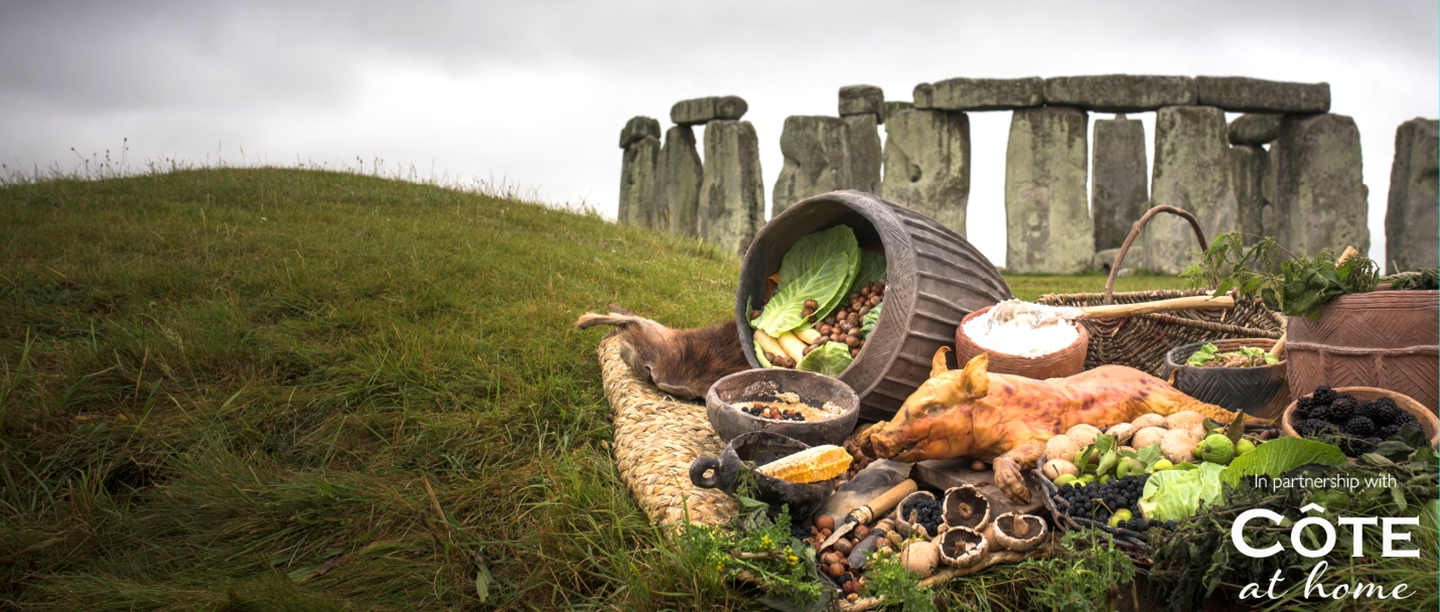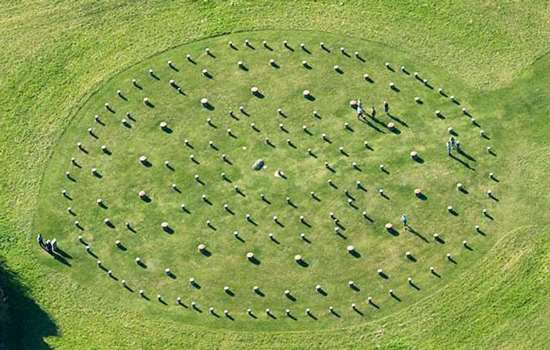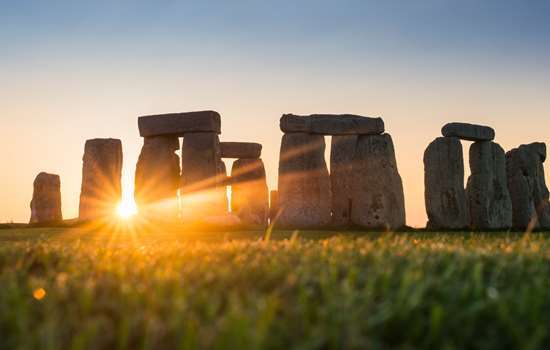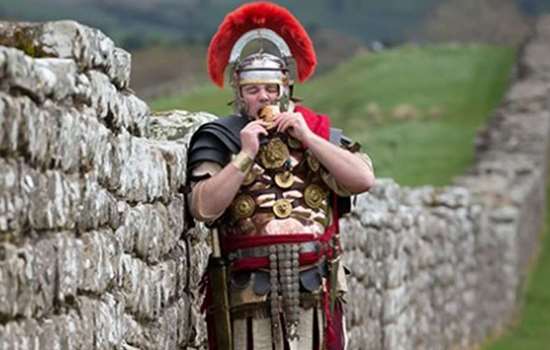Monumental feasts
Feasts were an important part of life during the late Neolithic period (3000–2400 BC) at various places in Britain, with these ancient gatherings involving long-distance travel, spectacular ceremonies and vast quantities of food. These feasts were likely to have been related to the construction and use of monuments such as Silbury Hill and Stonehenge.
Around 2500 BC, the people who built Stonehenge probably lived at Durrington Walls, a settlement about two miles away. Over 38,000 discarded animal bones have been found there. Of the bones and teeth excavated, 90% were from pigs, and the rest mostly from cattle. Many of the bones still had meat attached to them when discarded, suggesting that there was more than enough food to go round. Burnt foot bones suggest that pigs were often roasted over open fires.
Seasonal gatherings?
Durrington Walls was not the only place of feasting in southern Britain at that time. Evidence for feasting on a similar scale has been found at monuments such as Mount Pleasant henge near Dorchester, Dorset, at the timber enclosures near Silbury Hill and at Marden henge, both in north Wiltshire.
Analysis of the pig teeth from Durrington Walls has shown that many of them were killed at about nine months old. Since the piglets were most probably born in the spring, they were all being slaughtered at midwinter. This suggests that people were gathering for feasts at this time of year. Both Stonehenge and some of the timber monuments at Durrington Walls were built to align with the movements of the midwinter and midsummer sun. Were people feasting at Durrington Walls, before going to Stonehenge to witness the midwinter sunset?
By the late Neolithic period, people in Britain had been farming for more than 1,000 years, so they were expert at raising domestic animals for meat and milk, which seem to have been the most important elements of their diet. They also had the knowledge to cultivate and process cereals, although this doesn’t seem to have been on a large scale. They may have malted grains to make malt sugars or beer.
People also continued to gather wild foods such as mushrooms, berries and plants, and to hunt wild animals. Winter feasts might have coincided with times of plentiful food after the autumn harvest – hazelnuts, crab apples and berries, for example, would have been gathered and stored.
Listen to our podcast episode on the winter solstice at Stonehenge
Gathering places
Scientific analysis of the pig and cattle teeth from feasting sites such as Durrington Walls, Mount Pleasant, Marden and the palisaded enclosures near Silbury Hill (pictured) has shown that the animals were brought to these places from a variety of other locations. Dr Richard Magdwick, of Cardiff University, has led these studies, which have found that these animals were not raised locally but were raised in various locations across southern Britain, and possibly even further afield in western and northern Britain. These animals are likely to have been herded to the monuments for feasts, which would have been much easier than slaughtering them first and transporting the carcasses. So people were herding animals over long distances. People across Britain must have known about these famous gathering places and travelled there from afar, to help build the monument or to take part in ceremonies and feasts.
What's cooking?
The people taking part in these late Neolithic feasts used a type of pottery now known as Grooved Ware because of its geometric grooved decoration. It is often found at henges and ceremonial sites, and larger vessels seems to have been made for feasting, display and serving large quantities of food.
When these pots are used for cooking, some of the food molecules seep into the porous ceramic material. Dr Oliver Craig, of York University, has been studying the Grooved Ware pottery from Durrington Walls to extract these trace residues and identify them.
Large numbers of the pots were found to have been used for cooking pork and beef, but about a quarter of the them were found to contain dairy products – milk, butter, yoghurt or cheese. We know that people in Britain at this time were lactose-intolerant – they did not have the ability to digest raw milk – and therefore had to process milk into products like cheese and yoghurt so that they could digest it.
Most of the pots that had held dairy products were found in and around the Southern Circle, a timber ceremonial monument. Perhaps milk was part of the religious ceremonies that took place there. In many world cultures, milk is seen as a special substance, associated with purity and nourishment.
Creating communities
Many historical and contemporary societies across the globe are known to have held, or still hold, large feasts. These weren’t usually simple social and festive occasions, but were important events that formed part of competitions for positions of power and status.
Potlatch ceremonies held by Native American communities of the north-west Pacific coast involved great formal feasts displaying generous hospitality, which confirmed the social position of the person hosting the event. These memorable occasions might take years of planning and persuasion of others to gather the assets and resources needed. The extravagant feasts created debts and obligations that had to be repaid in subsequent years.
It is likely that the late Neolithic feasts in Britain also took long-term planning, to raise the animals and gather the resources needed, and to bring them over long distances. We don’t know whether they were competitive occasions, sponsored by an individual or a particular group.
Equally, lavish meals might also have been the way in which people created and maintained reliable social support networks, bringing a widely dispersed community together to affirm their identity and shared values. In addition, the feasts might have been the reward for people taking part in the great monument-building projects, taking place to celebrate the successful transport of enormous sarsen stones or large timber posts.
Learn more about life in the Neolithic period in this episode of The English Heritage Podcast
Feeding Stonehenge
The evidence from Durrington Walls tells us that people were travelling over long distances to take part in feasts and ceremonies, and probably also to take part in the building of Stonehenge itself. It shows that the monument was important beyond just the local area but was famous across other parts of Britain. But this also applies to the other feasting sites: the henges at Mount Pleasant and Marden and the West Kennet palisaded enclosures near Avebury and Silbury Hill. People were travelling around a lot in this period, and taking their animals and perhaps other resources with them. Were these the same people? Or were different dispersed communities coming together at different feasting and monument sites? We don’t yet know, but the archaeological evidence shows that this was a fascinating period of connectivity, of shared ideas and practices, and of lavish feasts and extraordinary building projects.
Organise your own feast with Côte At Home
Côte at Home delivers luxury, French-inspired meals directly to your door. Produced by the chefs behind the nationwide Côte Brasserie restaurants, you can choose from a range of set menus, French wines and artisan cheeses to create the perfect at-home experience.
Côte at Home’s luxury set menu box range provides you with everything you need for a celebratory spread, whether it’s for a weekend breakfast treat or a special date night. Order your first box from Côte at Home and, as an English Heritage Member, you will receive an exclusive discount of £10 (minimum order £50).



